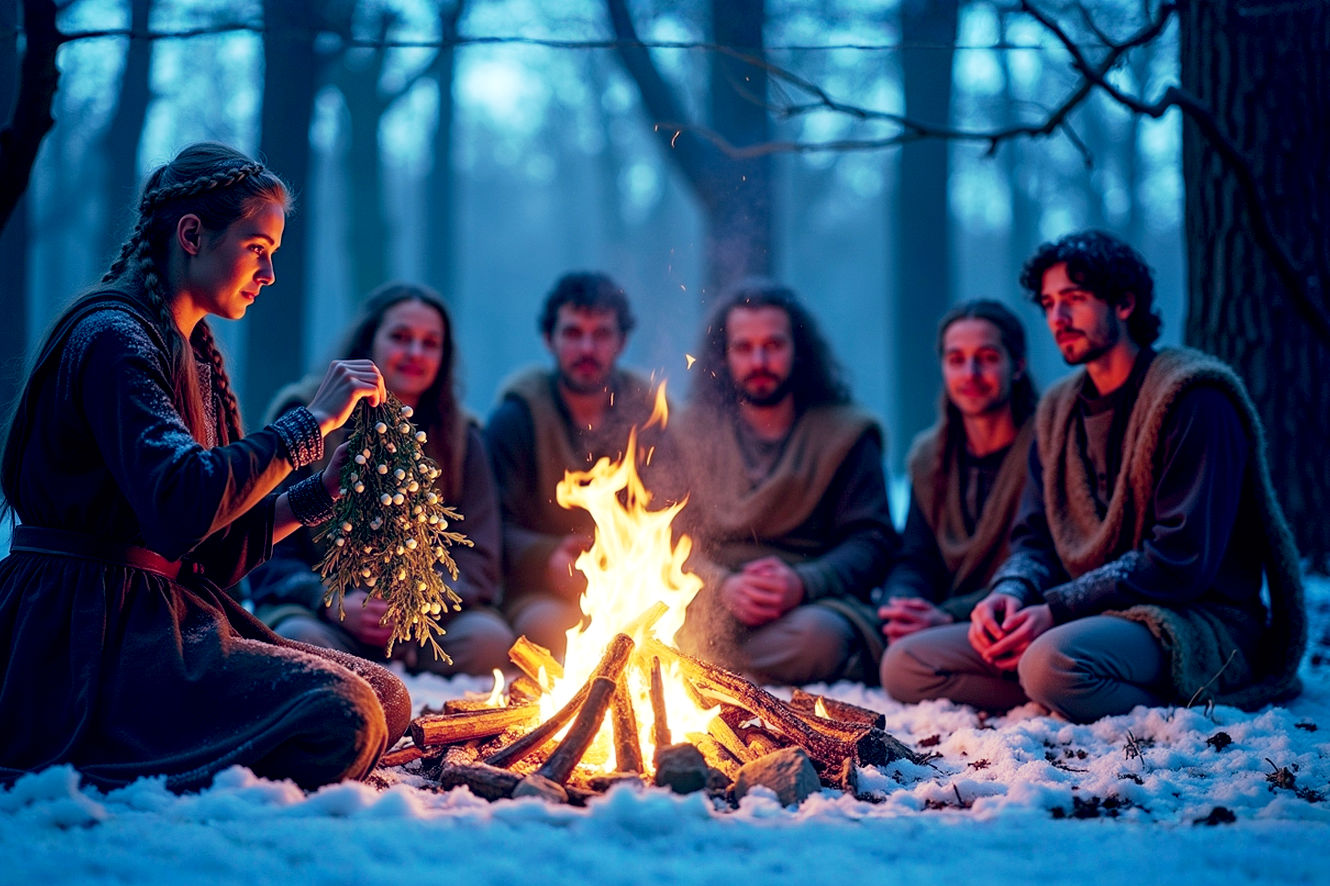This post may contain affiliate links. If you make a purchase through these links, we may earn a commission at no additional cost to you.
It stands as perhaps the most iconic symbol of the Christmas season, a beacon of light and life sparkling in our homes during the darkest, coldest days of the year. The Christmas tree, laden with ornaments and crowned with a star, feels like a tradition stretching back into time immemorial. But where did it come from? For many, its origins are shrouded in a festive mist, a blend of vague folklore and commercial charm. The real story, however, is far more fascinating—a rich tapestry woven from ancient pagan rites, medieval Christian plays, German folk customs, and the impassioned debates of reformers and royalty.
This isn’t just the story of a decorated fir. It’s a story of how Christianity, in its relentless mission to spread its message, absorbed, repurposed, and ultimately sanctified a symbol with deep, primordial roots. It’s a journey that takes us from the sacred groves of pre-Christian Europe to the very gates of the Garden of Eden, from the humble home of a German Protestant reformer to the lavish halls of Windsor Castle. Understanding the Christmas tree means understanding the dynamic, and often complex, interplay between faith, culture, and tradition. It’s a symbol that didn’t just appear fully formed but evolved over centuries, gathering layers of meaning until it became the beloved emblem of Christmas we recognize today.
So, let’s unravel this story together. We’ll strip back the tinsel and lights to uncover the tree’s true historical and theological foundations, exploring how a simple evergreen became an enduring and powerful symbol of Christian hope, redemption, and the promise of everlasting life.
The Ancient Echo: Evergreens in a Pre-Christian World
Before the Christmas tree could become a Christian symbol, it was simply a tree—but a very special kind. Long before the birth of Christ, ancient civilizations across the Northern Hemisphere revered evergreen trees and boughs for their remarkable ability to remain green and vibrant when all other plant life seemed to die. In the bleakness of winter, when the sun was weak and the days were short, the evergreen was a potent symbol of life, resilience, and the promise of the sun’s return.
This reverence wasn’t isolated to one culture; it was a near-universal phenomenon tied to the winter solstice, the shortest day of the year (around December 21st). For ancient peoples, this was a time of both fear and celebration. They feared the encroaching darkness and cold, but they also celebrated the turning point when the days would begin to lengthen again.
- Ancient Egyptians: In their worship of the god Ra, who had the head of a hawk and wore the sun as a blazing disk in his crown, the Egyptians celebrated the solstice as the moment Ra began to recover from his annual illness. To mark this triumph of life over death, they filled their homes with green palm rushes, symbolizing renewal and vitality.
- Roman Saturnalia: The Romans celebrated Saturnalia, a week-long festival in honor of Saturn, the god of agriculture. This hedonistic holiday, held in late December, involved feasting, gift-giving, and a temporary upending of social order. Romans decorated their homes and temples with evergreen boughs as a sign of the enduring life that would return to the fields in the spring.
- Norse and Germanic Tribes: In the harsh, cold climates of Northern Europe, the Vikings and other Germanic peoples held a deep respect for the evergreen. They believed these trees, particularly the fir, held special power. During the Yule festival, they would often bring evergreen branches—and sometimes whole trees—into their homes to ward off evil spirits and celebrate the promise of new life. The evergreen was a reminder that even in the depths of winter’s despair, the god of light, Baldur, would eventually return.
These pagan traditions are not the direct origin of the Christian Christmas tree, but they form its essential cultural bedrock. They established the evergreen as a powerful, pre-existing symbol of life in the midst of death. When Christianity spread into these regions, it didn’t simply erase these ancient customs. Instead, a long and complex process of syncretism began, where old meanings were not so much replaced as they were reinterpreted and absorbed into a new theological framework. The evergreen’s pagan association with survival and rebirth made it a perfect candidate for a new, Christian symbolism centered on eternal life through Christ.
The Missionary and the Oak: The Legend of St. Boniface
One of the most dramatic and enduring legends connecting the evergreen to Christianity is the story of St. Boniface, an English missionary who traveled to Germany in the 8th century to convert the pagan tribes. While the story is likely more hagiography than historical fact, its symbolic power has resonated for centuries and provides a crucial bridge between pagan and Christian traditions.
The legend, set around the year 723 A.D., centers on a sacred oak tree near Geismar, known as the “Thunder Oak of Donar” (or Thor, in Norse mythology). This massive tree was an object of intense veneration for the local Germanic tribes, who believed it was sacred to their god of thunder. To demonstrate the supremacy of the Christian God, Boniface, in a bold and defiant act, decided to fell the mighty oak in front of a large crowd of pagans.
As the story goes, just as Boniface struck the first blow with his axe, a mighty wind miraculously swept down and toppled the ancient tree, which shattered into four pieces. The pagans were stunned, seeing this as a sign of the power of Boniface’s God.
Here, the legend takes a pivotal turn. Standing in the place of the fallen oak was a small, young fir tree. Pointing to it, Boniface declared:
“This little tree, a young child of the forest, shall be your holy tree tonight. It is the wood of peace, for your houses are built of the fir. It is the sign of an endless life, for its leaves are ever green. See how it points upward to heaven. Let this be called the tree of the Christ-child; gather about it, not in the wild wood, but in your own homes; there it will shelter no deeds of blood, but loving gifts and rites of kindness.”
In this single, powerful narrative, several key symbolic shifts occur:
- From Paganism to Christianity: The violent, pagan power of the oak is replaced by the peaceful, humble fir.
- From Public Ritual to Private Devotion: The worship is moved from the “wild wood” to the intimacy of the home.
- From Sacrifice to Gift-Giving: The tree is no longer associated with bloody rites but with “loving gifts.”
- From Earthly Power to Heavenly Hope: The fir’s triangular shape is used to represent the Holy Trinity (Father, Son, and Holy Spirit), and its upward-pointing spire directs the faithful’s gaze toward heaven.
While historians doubt the literal truth of this event, its importance lies in its function as a founding myth. It provided a clear, compelling narrative that Christianized the evergreen, imbuing it with a new set of meanings that directly challenged and co-opted its pagan predecessors. The story of St. Boniface transformed the fir tree from a generic symbol of life into the specific “tree of the Christ-child.”
The Paradise Tree: A Medieval Link to Eden
While the legend of St. Boniface provided a powerful origin story, the more direct ancestor of the modern Christmas tree likely comes from a different tradition: the medieval “Paradise Plays.”
During the Middle Ages, when much of the population was illiterate, the Church used mystery and miracle plays to teach biblical stories to the masses. These plays were performed in public squares, often on feast days. One of the most popular was the Paradise Play, performed on December 24th, the feast day of Adam and Eve.
The play depicted the story of creation, the temptation of Adam and Eve, and their expulsion from the Garden of Eden. The central prop on stage was the “Paradise Tree,” a fir tree decorated with apples to represent the Tree of Knowledge of Good and Evil. Sometimes, round white wafers or pastries were also hung on the tree to symbolize the Eucharist—the promise of redemption that would come through Christ.
This tradition is critically important for several reasons:
- It explicitly links the fir tree to a core Christian narrative: The tree is no longer just a vague symbol of life but is now tied to the story of the Fall and the promise of salvation.
- It introduces the practice of decorating the tree: The apples are the earliest form of Christmas tree ornaments, directly representing the forbidden fruit. The wafers foreshadow the later addition of cookies, sweets, and other edible decorations.
- It connects the tree to Christmas Eve: By being performed on December 24th, the Paradise Play firmly placed this decorated fir tree within the Christmas season. The message was clear: the story of Christmas begins with the story of the Fall. Christ, the “second Adam,” was born to redeem humanity from the original sin committed at the foot of the Paradise Tree.
As the plays waned in popularity, the tradition of the Paradise Tree didn’t disappear. German families began to set up their own Paradise Trees at home on December 24th, keeping the symbolism alive as a private devotional practice. This custom, popular in western Germany, was the most direct forerunner of the Christmas tree as a domestic tradition.
The German Cradle: How Protestantism Shaped the Christmas Tree
The practice of bringing a decorated evergreen into the home truly took root and flourished in 16th-century Germany. It was here, in the heartland of the Protestant Reformation, that the Christmas tree as we know it began to emerge.
Interestingly, the Christmas tree was, for a time, primarily a Protestant custom. This was partly a reaction against the traditional Catholic symbol of the Christmas season: the Nativity scene, or crèche. While Catholics focused on the manger scene, many German Lutherans embraced the decorated tree as their unique emblem of the holiday.
The Martin Luther Legend
Another powerful legend, similar to the St. Boniface story, attributes the first illuminated Christmas tree to the Protestant reformer Martin Luther himself. According to the tale, one Christmas Eve around the year 1500, Luther was walking home through a forest. He was struck by the breathtaking beauty of the stars twinkling through the branches of the evergreen trees.
Wanting to recreate this celestial scene for his family, he brought a small fir tree into his home and decorated its branches with lit candles. He told his children that the candles represented the stars over Bethlehem on the night of Christ’s birth, and the tree itself symbolized Jesus, the light of the world who brings life eternal.
Like the Boniface story, there is no hard historical evidence to prove this event occurred. However, its symbolic resonance is undeniable. It provides a theological justification for the most magical element of the Christmas tree: the lights. The lights are not merely decorative; they are a direct representation of Christ as the Lux Mundi (Light of the World), dispelling the darkness of sin. The legend also firmly associates the tradition with one of Protestantism’s most revered figures, giving it a strong theological and cultural endorsement.
The Spread Through German Culture
Regardless of its precise origins, by the 17th and 18th centuries, the Tannenbaum was a well-established tradition throughout Germany. Records from Strasbourg in 1605 mention fir trees decorated with paper roses, apples, wafers, and sweets. The custom gradually spread from the upper classes to the general populace. German emigrants, soldiers, and merchants then began to carry this beloved tradition with them to other parts of Europe and eventually to America.
However, its adoption was not immediate. For many, it was still seen as a strange, foreign, and even pagan custom. The Christmas tree needed a royal seal of approval to truly go global.
A Royal Endorsement: How Queen Victoria Made the Christmas Tree Fashionable
For much of the 19th century, the Christmas tree remained a niche tradition outside of Germany. In Britain and America, it was viewed with suspicion by many, who saw it as a frivolous German oddity. This all changed thanks to one of the most influential trendsetters of the era: Queen Victoria.
Victoria’s mother was German, so she had been familiar with the custom from her childhood. But it was her German husband, Prince Albert, who is widely credited with popularizing the Christmas tree in the English-speaking world. In 1848, the Illustrated London News published a detailed engraving of the royal family—Victoria, Albert, and their children—gathered around a beautifully decorated Christmas tree at Windsor Castle.
The image was a sensation. Queen Victoria was immensely popular, and her domestic life was a subject of intense public fascination. If the royal family had a Christmas tree, then everyone wanted one. What was once a foreign custom almost overnight became the height of fashion in Britain.
The image was republished in American magazines, often with Victoria’s crown and Albert’s mustache removed to make the scene look more “American.” The effect was the same. The Christmas tree quickly became a must-have holiday fixture in the homes of the burgeoning middle class on both sides of the Atlantic.
This royal endorsement was the tipping point. It stripped the tree of its lingering pagan associations and its niche Protestant identity, transforming it into a mainstream, respectable, and highly desirable symbol of a happy, prosperous Christian family. The commercialization of Christmas was not far behind. Ornaments, which had previously been handmade, began to be mass-produced in Germany and exported around the world. The Christmas tree industry was born.
The Layers of Symbolism: Reading the Theology of the Tree
Over the centuries, the Christmas tree has accumulated a rich and complex vocabulary of Christian symbolism. It is not just a decoration; it is a theological statement, a visual sermon that can be “read” from its roots to its crown.
- The Evergreen: A Symbol of Eternal Life: This is the tree’s most fundamental meaning. Just as the evergreen remains alive in the dead of winter, Christ offers eternal life to believers, conquering sin and death. It speaks to the promise of resurrection and the unending nature of God’s love.
- The Shape: The Holy Trinity: The traditional triangular shape of the fir or spruce tree has long been interpreted as a symbol of the Holy Trinity—the Father, the Son, and the Holy Spirit, three persons in one God. Its upward-pointing form also serves as a visual reminder to direct one’s thoughts and prayers toward heaven.
- The Lights: Christ, the Light of the World: As the Martin Luther legend suggests, the lights on the tree—whether candles in the past or electric bulbs today—symbolize Jesus Christ as the Light of the World (John 8:12). He is the light that shines in the darkness, a beacon of hope, truth, and salvation that sin cannot extinguish.
- The Star or Angel Topper: The ornament at the very top of the tree holds special significance.
- A star represents the Star of Bethlehem, the celestial sign that guided the Magi (the Wise Men) to the infant Jesus. It is a symbol of divine guidance and the revelation of Christ to the Gentiles.
- An angel represents the angel Gabriel, who announced the birth of Jesus to the Virgin Mary, or the heavenly host that appeared to the shepherds in the fields, proclaiming the good news. It is a symbol of divine proclamation and joy.
- The Ornaments: Fruits of the Spirit and Memories of Faith: The decorations hanging on the branches carry their own layers of meaning.
- Apples and Balls: The earliest decorations, apples (and their modern glass-ball equivalents), hearken back to the Paradise Tree and the fruit of the Tree of Knowledge. They are a reminder of the original sin from which humanity needs redemption.
- Edible Decorations: Cookies, candies, and other treats symbolize the sweetness of God’s grace and the fruits of the Holy Spirit (love, joy, peace, etc.). They also connect to the wafers on the Paradise Tree, which symbolized the Eucharist.
- Handmade and Family Ornaments: These represent the personal history of a family’s faith journey, with each ornament holding a memory or story, passed down through generations.
- The Gifts Beneath: God’s Ultimate Gift: The practice of placing gifts under the tree is a reflection of the gifts of the Magi to the infant Jesus (gold, frankincense, and myrrh). More profoundly, the gifts symbolize the ultimate gift that God gave to humanity: his only Son, Jesus Christ, whose birth is the reason for the season.
When assembled, the Christmas tree is a comprehensive visual summary of the Christian story of salvation—from the Fall in Eden (the apples) to the promise of eternal life (the evergreen), guided by divine revelation (the star) and illuminated by Christ himself (the lights), all culminating in the celebration of God’s greatest gift to the world.
Debates, Denunciations, and Modern Interpretations
Despite its widespread acceptance, the Christmas tree has not been without its critics within Christianity. For centuries, and even today, some have viewed the tradition with suspicion, seeing it as a dangerous intrusion of paganism into Christian worship.
The Puritan leader Oliver Cromwell preached against “the heathen traditions” of Christmas carols, decorated trees, and any joyful expression that desecrated what he considered a sacred event. In 17th-century New England, the Puritan governor William Bradford was deeply troubled by the festive celebrations of his non-Puritan neighbors. For a time, the celebration of Christmas was even outlawed in Boston.
These objections often center on a passage from the Book of Jeremiah (10:2-4):
“Thus saith the Lord, Learn not the way of the heathen… For the customs of the people are vain: for one cutteth a tree out of the forest, the work of the hands of the workman, with the axe. They deck it with silver and with gold; they fasten it with nails and with hammers, that it move not.”
On the surface, this seems like a direct condemnation of the Christmas tree. However, most biblical scholars and theologians argue that this passage is not about decorative trees but is instead a polemic against the creation of wooden idols. The passage describes carving a tree into a figure, overlaying it with precious metals, and then worshipping it as a god—a practice far removed from the symbolic use of a Christmas tree in a Christian home.
Today, most mainstream Christian denominations have fully embraced the Christmas tree, seeing its pagan roots as successfully “baptized” and its symbolism as a rich and meaningful expression of Christian faith. For billions around the world, it is not an object of worship but a beautiful and powerful tool for teaching and remembrance—a focal point for family, faith, and the enduring story of Christmas.
From a pagan symbol of survival to a Christian emblem of salvation, the journey of the Christmas tree is a testament to the power of faith to infuse culture with new and profound meaning. It stands as a silent, sparkling witness to the story of the Fall and redemption, a reminder that even in the darkest winter, the light and life of Christ endure.






